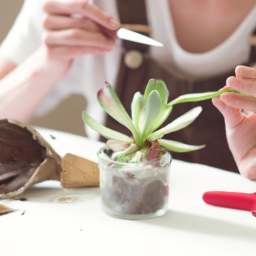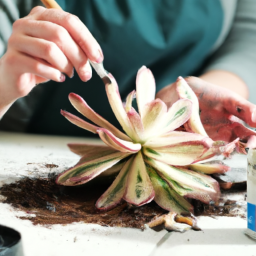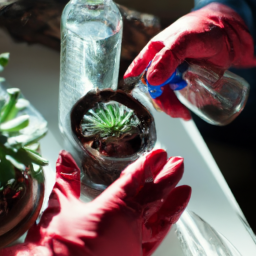
Are you looking to add some greenery to your home or office? Succulents are a popular choice for plant enthusiasts due to their low maintenance and unique appearance. In this blog post, we will provide you with care instructions for succulents to help you keep your plants healthy and thriving. Whether you are a seasoned succulent owner or a beginner looking to add some green to your space, these tips will ensure your succulents stay happy and vibrant. Let’s dive into how to care for these beautiful plants!
Proper Watering Techniques for Succulents
Welcome to our guide on caring for succulents! Succulents are beautiful and low-maintenance plants that are perfect for adding a touch of green to your home or garden. One of the most important aspects of caring for succulents is proper watering techniques. In this article, we will discuss how to water your succulents to ensure they thrive and stay healthy.
Understanding Succulent Watering Needs
Before we dive into the specifics of watering succulents, it’s important to understand their unique watering needs. Succulents are desert plants that store water in their leaves, stems, and roots. They are adapted to survive in arid conditions with infrequent rainfall. Overwatering is one of the most common mistakes people make when caring for succulents, as it can lead to root rot and other issues.
When it comes to watering succulents, less is more. These plants prefer to dry out between waterings, so it’s essential to let the soil completely dry before watering again. The frequency of watering will depend on factors such as the type of succulent, the size of the pot, and the climate in which you live. In general, it’s better to underwater than overwater succulents.
One way to determine if your succulent needs water is to feel the soil. Stick your finger into the soil about an inch deep – if it feels dry, it’s time to water. If the soil is still moist, wait a few more days before checking again. Remember, it’s better to err on the side of underwatering than overwatering.
Best Practices for Watering Succulents
When it’s time to water your succulents, there are a few best practices to keep in mind. First, use a well-draining potting mix specifically designed for succulents. This will help prevent water from pooling at the bottom of the pot, which can lead to root rot. Terra cotta pots are a great choice for succulents, as they allow for better airflow and drainage.
When watering your succulents, aim to water the soil directly rather than the leaves. Avoid getting water on the leaves, as this can lead to rot and other issues. Water the soil until it’s evenly moist, but not soggy. Allow any excess water to drain out of the bottom of the pot, and empty the saucer to prevent water from sitting in the pot.
During the growing season, which is typically spring and summer, succulents may need more frequent watering. However, during the dormant season in fall and winter, they will require less water. Adjust your watering schedule accordingly to meet the needs of your succulents throughout the year.
Troubleshooting Overwatered Succulents
If you suspect that your succulent has been overwatered, there are a few steps you can take to help it recover. First, remove the plant from its pot and inspect the roots. Trim away any mushy or blackened roots, as these are signs of root rot. Allow the plant to dry out for a few days before repotting it in fresh, well-draining soil.
After repotting, refrain from watering the succulent for at least a week to allow the roots to recover. Gradually reintroduce water, following the proper watering techniques we discussed earlier. Monitor the plant closely for signs of improvement, such as new growth and healthy roots.
By following these proper watering techniques for succulents, you can ensure that your plants stay healthy and thrive. Remember to pay attention to the unique watering needs of succulents and adjust your watering schedule accordingly. With the right care, your succulents will bring beauty and life to your home or garden for years to come.

Ideal Light Conditions for Succulent Care
When it comes to caring for your succulents, providing the right amount of light is crucial for their health and growth. Succulents are known for their ability to thrive in various light conditions, but understanding their specific needs will help you ensure they are happy and thriving. In this guide, we will discuss the ideal light conditions for succulents and how to provide them with the perfect environment to flourish.
Understanding Succulents’ Light Requirements
Succulents are plants that have adapted to survive in arid environments with limited access to water. As a result, they have developed the ability to store water in their leaves, stems, and roots, making them well-suited for dry conditions. When it comes to light, succulents generally prefer bright, indirect sunlight. However, the amount of light they need can vary depending on the species.
Some succulents, such as Echeverias and Haworthias, prefer bright, indirect light and can even tolerate some direct sunlight. On the other hand, succulents like Gasterias and Sansevierias prefer low light conditions and can thrive in shady areas. It’s important to research the specific light requirements of your succulents to ensure they are getting the right amount of light.
Exposure to too much direct sunlight can cause succulents to become sunburned, leading to brown spots on their leaves and overall decline in health. On the other hand, insufficient light can result in leggy growth and poor coloration. Finding the right balance is key to keeping your succulents happy and healthy.
Providing the Right Light Conditions for Succulents
When it comes to providing the right light conditions for your succulents, placement is key. Place your succulents in a location where they will receive bright, indirect sunlight for most of the day. A south-facing window is often the best choice, as it provides the most consistent light throughout the day.
If you notice that your succulents are not getting enough light, consider supplementing with a grow light. LED grow lights are a great option for providing the right amount of light without overheating your plants. Position the grow light above your succulents and leave it on for 12-14 hours a day to mimic natural sunlight.
During the summer months, it’s important to protect your succulents from intense afternoon sun, as this can cause sunburn. Consider moving them to a shadier location or providing some shade with a sheer curtain. In the winter, when sunlight is less intense, you may need to move your succulents closer to the window to ensure they are getting enough light.
Monitoring Light Conditions and Adjusting as Needed
It’s important to regularly monitor the light conditions your succulents are receiving and make adjustments as needed. Keep an eye on the color and shape of their leaves – if they start to stretch or lose their vibrant color, they may not be getting enough light. On the other hand, if you notice signs of sunburn, such as brown spots or wilting, they may be getting too much light.
Remember that each succulent is unique and may have different light requirements, so it’s important to observe how they respond to their current environment. By providing the right amount of light and making adjustments as needed, you can ensure that your succulents thrive and continue to bring beauty to your home.

Tips for Repotting and Soil Maintenance for Succulents
Choosing the Right Time to Repot
When it comes to repotting your succulents, timing is key. The best time to repot your succulents is in the spring or early summer, when they are actively growing. This is because they will be better able to recover from the stress of being repotted during their growing season. If you notice that your succulent is outgrowing its current pot, has roots growing out of the drainage holes, or is not thriving as well as it used to, it may be time to repot.
Before repotting your succulent, make sure to water it a few days beforehand. This will make it easier to remove the plant from its current pot and reduce the risk of damaging the roots. When repotting, gently loosen the roots and remove any dead or rotting roots. Be sure to use a well-draining soil mix specifically designed for succulents to prevent root rot.
After repotting, place your succulent in a location with bright, indirect light and allow it to settle into its new home. Avoid watering your succulent for at least a week after repotting to give the roots time to adjust to their new environment.
Soil Maintenance and Fertilization
Proper soil maintenance is essential for the health of your succulents. Succulents thrive in well-draining soil that allows excess moisture to escape quickly. A good succulent soil mix should contain a combination of potting soil, perlite, and coarse sand to provide the right balance of nutrients and drainage.
When it comes to fertilizing your succulents, less is more. Succulents are not heavy feeders and too much fertilizer can actually harm them. A diluted, balanced fertilizer can be applied sparingly during the growing season, but be sure to follow the instructions on the label carefully.
In addition to proper soil and fertilization, it is important to monitor the moisture levels of your succulents. Overwatering is one of the most common causes of succulent death, so it is important to allow the soil to dry out completely between waterings. Succulents are designed to store water in their leaves, so they are more tolerant of drought than overwatering.
Pest Control and Disease Prevention
Succulents are generally low-maintenance plants, but they can still fall victim to pests and diseases if not properly cared for. One of the most common pests that affect succulents is mealybugs, which are small, white insects that feed on the sap of the plant. To prevent mealybugs, regularly inspect your succulents for signs of infestation and treat them with a mild insecticidal soap if necessary.
Another common issue with succulents is root rot, which is caused by overwatering or poor drainage. To prevent root rot, make sure to use a well-draining soil mix and allow the soil to dry out completely between waterings. If you notice any signs of root rot, such as yellowing or mushy leaves, remove the affected parts of the plant and repot it in fresh soil.
By following these tips for repotting and soil maintenance, you can ensure that your succulents stay healthy and thriving for years to come. Remember to pay attention to the needs of your succulents and adjust your care routine as needed to keep them happy and beautiful.
I’ll leave you with these final thoughts
Succulents are a popular choice for indoor plants due to their unique shapes and low-maintenance nature. However, many people struggle to keep their succulents thriving because they don’t know how to properly care for them. To ensure your succulents stay healthy and vibrant, it’s important to follow a few key care instructions.
First and foremost, succulents need plenty of sunlight to thrive. Place them in a sunny spot where they can get at least six hours of sunlight each day. Additionally, make sure to water your succulents sparingly. Overwatering is one of the most common mistakes people make when caring for succulents, so be sure to let the soil dry out completely between waterings. Finally, make sure to use well-draining soil and a pot with drainage holes to prevent root rot. By following these simple care instructions, you can enjoy beautiful, healthy succulents in your home for years to come.
Frequently Asked Questions (FAQ):
Q1. How often should I water my succulents?
A1. Succulents have unique watering needs. It’s best to water them only when the soil is completely dry. Depending on the climate and the type of succulent, this could range from once a week to once every few weeks.
Q2. What type of soil is best for succulents?
A2. Succulents thrive in well-draining soil that allows excess water to flow out easily. A cactus or succulent mix from your local nursery is a great option, or you can mix your own using sand, perlite, and potting soil.
Q3. How much sunlight do succulents need?
A3. Succulents love sunlight, so it’s best to place them in a spot where they can get at least 6 hours of indirect sunlight per day. However, be cautious of too much direct sunlight, as it can cause sunburn on the leaves.
Q4. Do succulents need fertilizer?
A4. Succulents are low-maintenance plants and don’t require frequent fertilizing. You can fertilize them with a diluted succulent fertilizer once or twice a year during their growing season in spring and summer.
Q5. How do I prevent my succulents from getting pests?
A5. To prevent pests like mealybugs and spider mites, regularly inspect your succulents for any signs of infestation. You can also use a neem oil solution to treat and prevent pests from damaging your plants.

James Wong is a renowned ethnobotanist, plant scientist, and local television presenter. With a passion for demystifying plant science, he is known for translating complex botanical concepts into practical advice for everyday plant enthusiasts. James’s expertise spans from traditional gardening to cutting-edge plant technologies, making his insights accessible and informative.


